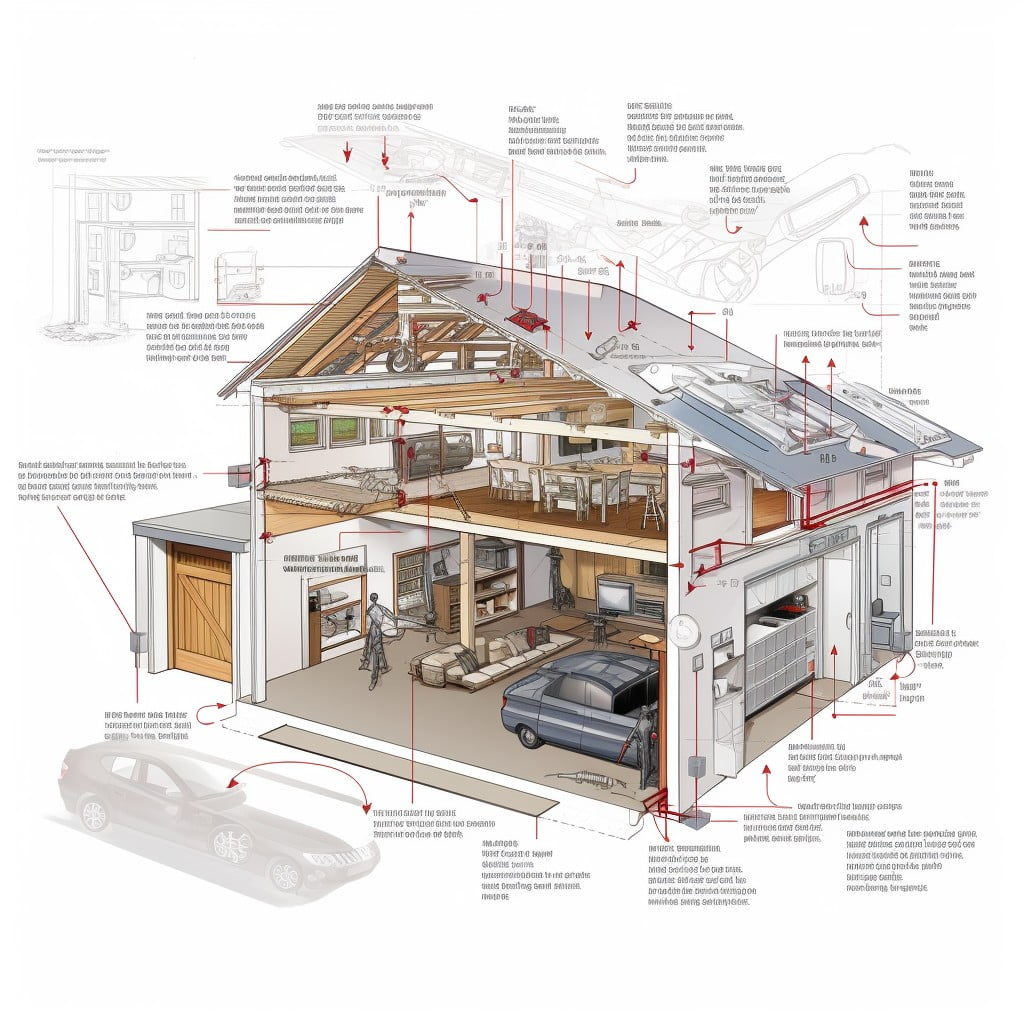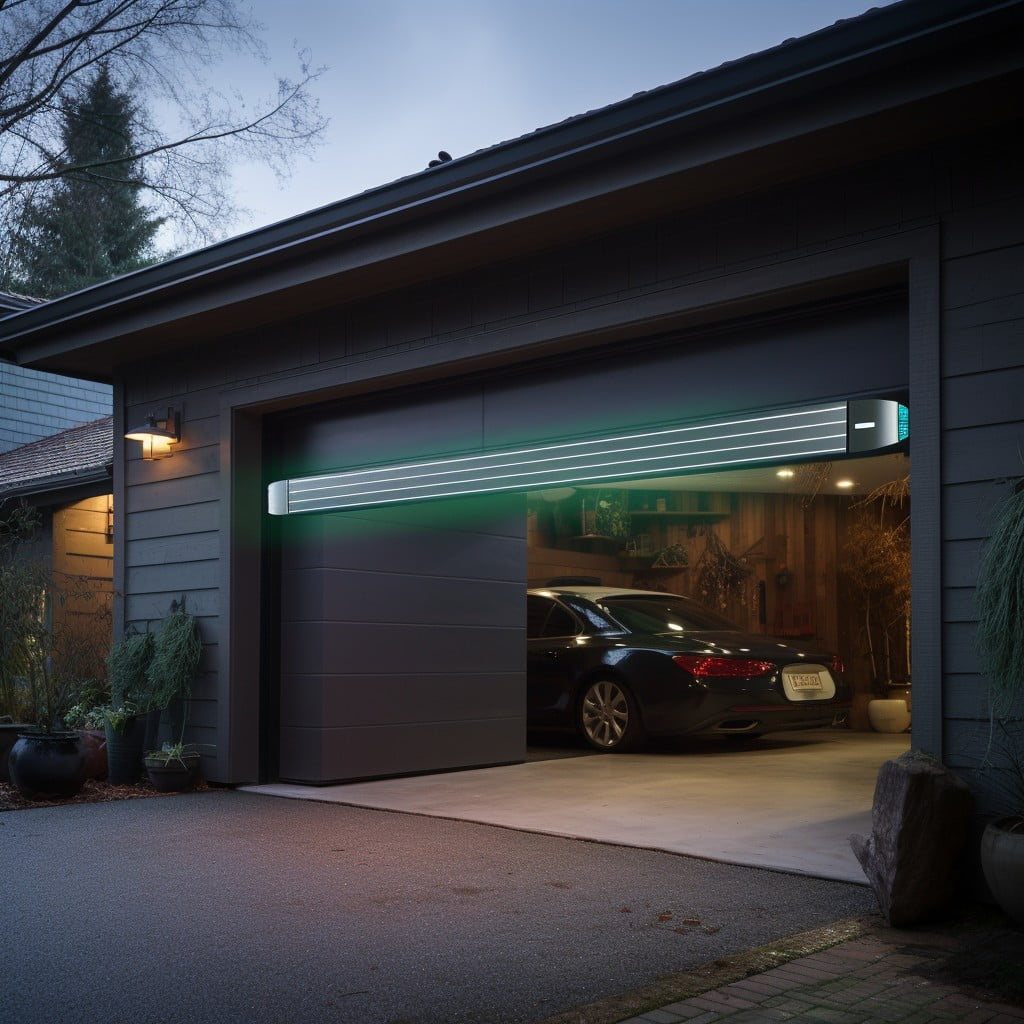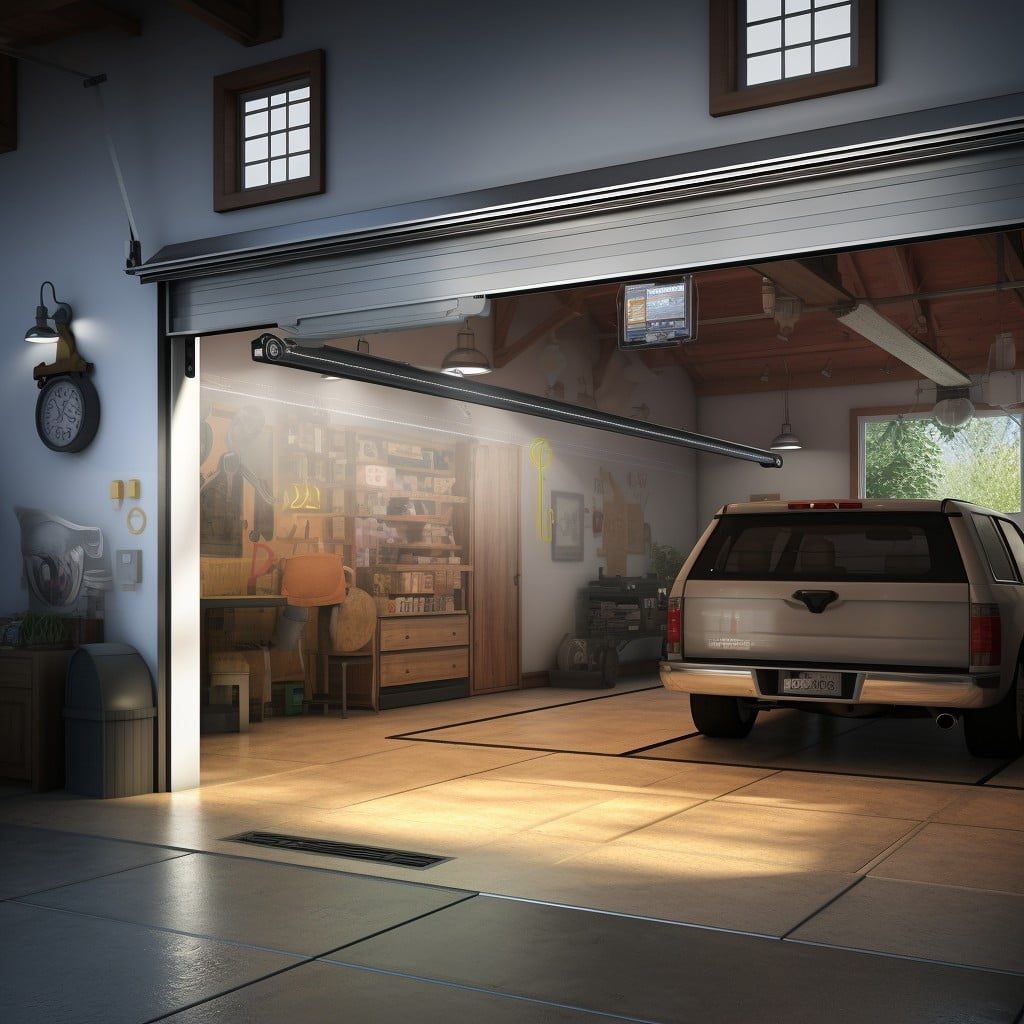Uncover the steps to successfully troubleshoot garage door sensors, ensuring smooth and safe operation of your garage door.
Garage door sensors, also known as photoelectric sensors, are designed for safety measures, but there are times when they may need to be bypassed. Whether it’s a malfunctioning sensor or a temporary need for unrestricted access, tricking garage door sensors is a simple process that involves blocking the sensor’s beam or disconnecting it. However, it’s important to note that overriding these safety features should be done with caution. This article will guide you through the process step-by-step, ensuring you understand the implications and precautions necessary when tricking garage door sensors.
Key takeaways:
- Keep sensors clean and obstacle-free for proper functionality.
- Garage door sensors work by detecting obstructions and sending signals to reverse the door’s movement.
- Types of garage door sensors include photoelectric and pressure sensors.
- Regularly inspect and align sensors to ensure their proper functioning.
- Bypassing garage door sensors should only be done with caution and temporary purposes.
Understanding Garage Door Sensors and Their Functionality

Garage door sensors, also known as photoelectric sensors, are crucial safety features in modern garage door systems. Positioned approximately two inches above the floor level on either side of the door, these sensors use an invisible beam of light as a tripwire.
The fundamental idea behind these sensors is that they prevent the door from closing whenever the beam gets interrupted, therefore providing a safeguard against potential accidents. They are specifically designed to protect children, pets, or any objects that might accidentally be in the path of the descending garage door.
Understanding the working mechanism of these sensors can further help in maintaining their functionality. When the garage door is ordered to close, if the sensor’s beam path remains clear, the door proceeds to close fully. However, should any object break the beam, a signal is sent to the opener to reverse the action, causing the door to stop and reverse to its fully open position. Thus, these sensors are instrumental in ensuring the safe operation of your garage.
Additionally, these sensors support the auto-stop and auto-reverse features on garage doors – critical functions that prevent accidents from faulty or failing systems. They also come with an LED light indicator that communicates the operational status of the sensors. Finally, under regular conditions, these sensors require minimal maintenance; just keep the lens clean and free from dirt and cobwebs, and ensure their path remains unblocked.
Types of Garage Door Sensors: Photoelectric Sensors and Pressure Sensors

Among the varied types of garage door sensors, Photoelectric and Pressure sensors are the most common.
Photoelectric sensors work on a rather simple yet effective principle – they emit an invisible beam of light between two points.
If anything interrupts this beam while the garage door is in operation, the door automatically stops and reverses to prevent any accidents.
On the other hand, Pressure sensors act as a safety precaution on garage floors.
Fitted underneath the door, they detect pressure changes.
Should the door come into contact with an object while closing, the pressure sensor triggers a reversal.
Both these sensors play crucial roles in garage safety, working in tandem to ensure all-around protection.
From preventing property damage to avoiding accidental harm to loved ones, their importance can’t be overstated.
Garage Door Sensor Mechanisms: How They Work

Garage door sensors operate on a fairly simple principle, albeit with a vital purpose: preventing accidents. They are usually installed on either side of the door, each housing an infrared beam. One sensor functions as the emitter, while the other acts as the receiver. Thus, an invisible line of communication is established across the width of the garage door.
The essence of this set-up is to detect any obstruction that blocks the infra-red beam during the operation of the door. Once an obstruction has been detected, the sensor sends a signal to the garage door’s motor unit to halt or reverse its direction, thereby preventing any potential accidents.
This mechanism helps ensure that the garage door does not close on any objects, vehicles, or, importantly, people and pets. Maintenance for these sensors is integral to their proper functioning. Regular sensors check should be performed, ensuring they’re clear of dirt and debris that can interfere with the beam.
Remember that ambient lighting conditions, such as direct sunlight, can occasionally cause sensors to malfunction. In such cases, specialized sun shields for the sensors can be a practical solution.
Extremely cold environments might also affect the sensors’ performance due to the condensation on the lens. Infrared beam range could be impaired and it is pertinent to keep the lens warm or install a suitable cover.
Finally, if your garage door sensors are not properly aligned, the door may fail to function as intended. Employ the right tools and follow the correct alignment procedure to fix any alignment issues, ensuring optimal performance.
Identifying Physical Obstructions in Garage Doors

Upon experiencing issues with your garage door sensors, the initial step involves a thorough inspection for any substantial blockages inhabiting the sensor’s sightline. These could range from leaves, cobwebs, or dirt that tends to build up over time. Utilize a soft brush or cloth to clear off any such debris gently. Avoid using excessive force as this could potentially misalign the sensors.
Nestled right off the ground, garage door sensors are naturally inclined to acquire a fair bit of dust, mud, or even snow when applicable. Confirm that they are clean and obstacle-free. Subsequently, check for any items stored in your garage that could inadvertently interfere with the sensor’s path.
Doing this physical sweep significantly saves you time and resources by identifying any surface level issues before diving into more complex aspects of troubleshooting a garage door sensor.
Impact of Sunlight On Garage Door Sensors Functioning
Sunlight has a unique effect on photoelectric garage door sensors. These sensors work by shooting a beam of light across the door, if something obstructs the beam of light, the door stops closing. However, when the sun is strong and directly shining onto the sensor, it can essentially ‘trick’ the sensor into thinking something is blocking the door, even when the path is entirely clear. This is because the sensor perceives the bright sunlight as the light beam becoming obstructed.
To tackle this issue, consider installing a light shade or visor directly over the sensor. This shields the sensor from the sun without interfering with the invisible light beam. You could also adjust the sensor’s angle so it’s less likely to be affected by the direct sunlight.
In the case of persistent issues, consider switching to different types of sensors that are not affected by sunlight. Always remember, safety is a priority, and garage door sensor functionality must not be compromised.
Checking and Aligning the Garage Door Sensors
Examine both sensors carefully; the LED lights serve as a great indicator of alignment. If both are steadily lit, your sensors are correctly positioned. If one or both are blinking, an adjustment is required.
Follow these steps for proper alignment:
- 1. Loosen the screws securing the sensors. Do not fully remove them.
- 2. Gently swivel your sensors until both LED lights remain steady.
- 3. Securely tighten the screws back into place once alignment is verified.
Always remember that alignment is crucial in the functioning of the sensors. It ensures an obstruction-free path for the infrared light to travel, resulting in the proper functioning of your garage door. Extra care should be taken not to knock the sensors out of alignment during routine garage cleaning or maintenance.
Examining Wiring of Garage Door Sensors
Upon confirming that the sensors are clear, in alignment, and not being affected by sunlight, the next step involves a close look at the wiring. This can be at times the cause of sensor malfunction. Do follow these steps:
1. Check the terminal screws where sensor wires are attached to the motor unit. Ensure they’re tight and the wires are properly inserted.
2. Examine the wires running from each sensor to the motor unit, watching for cut or worn insulation, which could cause short circuits, or breaks, which could render the sensors ineffective.
3. Take note of any loose or disconnected wires. If wires are disconnected, reconnect carefully following manufacturer instructions.
Remember not to tamper with internal wiring without professional guidance as it might pose a risk and potentially void your warranty. Always prioritize safety in any garage-related work. Whenever unsure, solicit the help of a skilled electrician or garage door technician.
Methods of Fixing an Automatic Garage Door Sensor
Begin by cleaning the lens using a soft cloth, ensuring that dust or dirt is not affecting the sensor’s performance. If the problem persists, proceed to check the alignment. Each sensor has an LED light that illuminates when they are aligned correctly. If you notice one or both lights are off, gently adjust the brackets holding the sensor until both lights are on.
In some cases, there may be a problem with the wiring of the sensor. Examine the wires for any signs of damage or disconnection and resolve, if feasible. For more complex wiring issues, it’s advisable to hire a professional to avoid creating detrimental electrical problems.
Also, if your remote control does not work while trying to close the door but operates well when opening, check your remote battery. A low battery often results in a weak signal, making it difficult to close the door.
Lastly, it’s good to be aware of the external factors that can interfere with your garage door sensor. For instance, strong sunlight can trick the sensor into thinking that there’s an obstruction. In this situation, you might want to consider purchasing a sunlight filter to resolve the issue.
Options to Use Garage Door Opener Without the Sensors
A manual release mechanism offers one possible alternative, requiring physical presence to operate the door. It disconnects the door from the automatic system permitting you to open and close it by hand.
Utilizing a remote control unit is another often-used approach. It necessitates the pairing of the operator with an individual remote, independent of the sensors.
Alternatively, some garage doors feature a keypad system mounted outside for easy access. With the correct code, the door can be triggered to open or close, again working independently from the sensors.
However, it cannot be stressed enough that these options should be used responsibly to ensure safety and security. Always remember that sensors are primarily installed as safety measures to prevent accidents and unwanted entries, so any bypass should be temporary, while you fix or replace the malfunctioning sensors, and maintain garage door safety.
When and How to Replace Garage Door Sensors
Regular maintenance can extend the lifespan of your sensors. Still, the need for replacement can arise due to aging, persistent malfunctions, or high accident-related damages.
1. Spotting Trouble: Consistent false alarm or unpredictable door operations are often symptoms of failing sensors. A flickering LED light, instead of a steady one, also indicates sensor issues.
2. Buying a Replacement: Ensure you purchase sensors matching the specifications of your garage door opener. Compatibility is critical for seamless functionality.
3. Safety First: Before replacement, disconnect the garage door opener from the power source to avoid electrocution.
4. Removal and Installation: Unmount the old sensors and detach them from the brackets. Afterwards, connect the new sensors to the wiring, align them properly, and securely fasten them to the brackets.
5. Post-Installation Check: After replacement, operate the garage door multiple times to confirm smooth functionality.
Remember to consult your garage door opener’s manual for specific instructions, or consider professional assistance for guaranteed safe and efficient replacement.
Legally Bypassing Garage Door Sensors
Bypassing sensors isn’t an intended method of operating garage doors and must be done in adherence to safety protocols.
1. Acquaint Yourself with Local Regulations: Your first step should be to understand the specific laws regarding garage door operations in your region. Some local code enforcement may prohibit tampering with safety devices, including garage door sensors.
2. Consider Your Safety: Bypassing sensors can pose safety risks. Always undertake an informed risk assessment to make sure you’re not putting people or property in harm’s way.
3. Consult a Professional: Garages involve complex mechanics and electricity, which can be dangerous if mishandled. In many cases, repairs or modifications are better handled by a licensed garage door professional.
4. Use a C-Clamp: If the need is temporary, use a C-clamp on the garage door track above one of the rollers to hold the door open while the sensors are bypassed.
5. Utilize the Manufacturer Override: Many garage door openers have a switch or button that allows you to operate the door without the sensors, known as the manufacturer override.
Remember, these points are for your understanding and should be executed only if you have the required knowledge and expertise.
Safe Techniques to Trick Garage Door Sensors
To safely trick your garage door sensors, the following techniques can be employed:
1. ‘Blocking the Beam’ Technique: This involves safely placing an object, which is about the height of the sensor, directly in the sensor’s path. It prevents the beam from being interrupted, tricking the system into thinking the path is clear.
2. ‘Shutting off Power’ Technique: You can manually override your garage door sensors by turning the power off. This can be achieved by unplugging the garage opener. Once turned off, the sensors are disabled, and you can open or close your garage door manually.
3. ‘Using a Remote Universal Garage Door Opener’ Technique: This method involves the use of a remote to trick the sensor. You connect the remote to the opener and bypass the sensors entirely.
4. ‘Securing the Sensors’ Technique: Place each sensor into a tube to keep it steady and prevent it from getting knocked out of alignment. If the sensors are secure and aligned, you will prevent false signals.
Remember, while these methods can be useful in certain situations, they should be handled with care as misuse can lead to accidents.
FAQ
Can I bypass the sensors on my garage door?
Yes, you can bypass the sensors on your garage door by pulling the emergency release cord to disconnect the garage door from the opener.
Will any sensor work with garage door opener?
While garage door sensors are often universal, it's best to use sensors produced by the same manufacturer as your garage door opener for optimal compatibility.
Should both garage door sensors be lit?
Yes, both garage door sensors should be lit to indicate proper alignment.
How do you correctly align garage door sensors?
Garage door sensors can be properly aligned by positioning them directly across from each other on both side of the door and ensuring both sensors' LEDs are lit solid, indicating successful alignment.
What are the common causes of garage door sensor malfunctions?
Common causes of garage door sensor malfunctions include misaligned sensors, dirt or dust covering the sensor, damaged wires, or an expired sensor lifespan.
Is it possible to replace garage door sensors by yourself?
Yes, you can replace garage door sensors by yourself by following the correct procedures and using the right equipment.